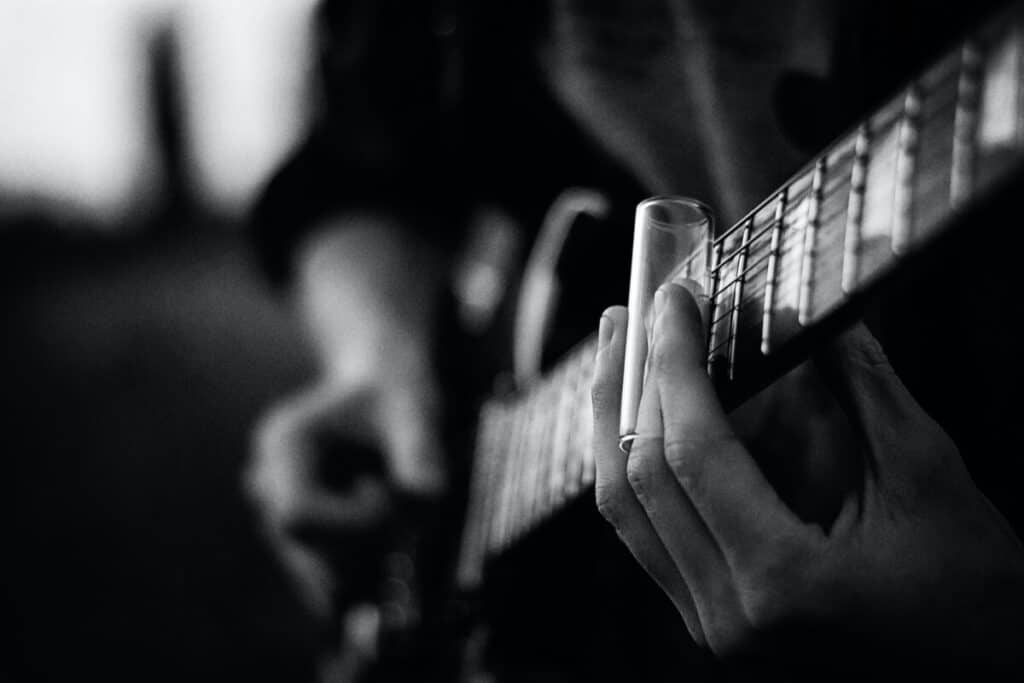
Learning to play slide guitar is a great way to expand your sound and skills and your guitar. You don’t need a new instrument or any super expensive gear to access a totally unique new sound. In fact, old school players literally used the necks of glass bottles. This is where the term “bottleneck slide guitar” came from.
However, since many players are new to slide guitar, a lot of questions come up about this style. Below, I’ll answer all of the most common slide guitar questions, including how to learn slide guitar and which guitar slide I recommend.
What Is Slide Guitar Playing?
In slide guitar playing, a slide is used to fret the notes on the fretboard, rather than one’s fingers. This allows for some unique benefits that one simply can’t get by playing guitar in the traditional fashion. For example, many people find that the slide guitar more accurately imitates the human voice. Intense vibrato is possible with the slide.
Many guitarists also find they can slide farther up the fretboard faster with a slide than they can with their fingers, which also lends a unique sound.
Slide guitar can be played both on the acoustic and the electric. Perhaps the two most popular electric slide guitar players are Duane Allman and Derek Trucks. Derek Trucks is carrying the torch of slide guitar, and is likely the most masterful player on the scene today. You can hear some of his playing below:
Slide guitar also sounds amazing on the acoustic. Here’s Derek Trucks playing slide again, but this time on an acoustic guitar:
Is Slide Guitar Easier or Harder than Regular Guitar?
Slide guitar isn’t necessarily easier or more difficult than regular guitar playing. There are simply important differences that you’ll have to adjust to. Some of these may be more difficult or take more time than others.
Here are some of the challenges of slide guitar:
- Slide guitar essentially turns your guitar into a “fretless” instrument. Your ear becomes much more important, because you can’t simply play in the frets and be guaranteed to be in tune, as you would be with regular guitar playing.
- Slide guitar is rarely played in standard tuning. If you aren’t familiar with alternate turnings, this can take some getting used to.
- Most slide guitarists pick with their fingers, and use other fingers to mute the remaining strings. This is very different from using a pick and just having the rest of the strings muted with regular guitar. This new picking and muting technique can be knack-y and difficult to learn at first.
What Tuning Should I Use For Slide Guitar?
The most common slide guitar tunings are Open E, Open A, Open D, and Open G tuning. If you like the style of Duane Allman or Derek Trucks, they are most often playing in Open E tuning, so perhaps learn that tuning first.
The reason the slide guitar is often tuned to an open tuning is because it makes it much easier to play chords. It essentially turns the entire guitar into a chord (in Open E, for example, the open strings form an E Major chord). This way, you can hold your slide above any given fret and easily play a major chord by playing any of the strings.
For example in Open E tuning, placing the slide over all the strings on the 5th fret creates an A chord… on the 7th fret it creates a B chord, and so on.
In Open E tuning, the guitar is tuned (low to high): E B E G# B E.
How to Learn Slide Guitar
To start learning slide guitar, I recommend starting out on YouTube. Slide guitar is not as common as regular guitar playing, so it can be difficult to find an experienced teacher in your local area. YouTube has nearly everything you would need to get started learning slide guitar.
Here’s an example of how to play slide guitar in Open E tuning for beginners:
The other thing to consider, however, is that slide guitar will be a lot easier if you already have a solid foundation of technique and theory built up on the guitar from playing regularly. I’d recommend just learning traditional guitar for at least a year or two before diving into a whole new style of playing like slide guitar.
What Guitar Slide Should I Buy?
In general, I recommend players get a glass slide as their first guitar slide. There are other options, like steel or other metal slides, but these tends to be very noisy and harsh, especially if you’re just starting out and learning how to mute unplayed strings.
My favorite glass slide is D’Addario’s Glass Slide (from Amazon):
This glass slide is perfect for both acoustic and electric slide guitar playing.
If you get a high quality glass slide, learn open E tuning, and practice regularly, you’ll definitely make some amazing progress on the slide guitar. Good luck and happy picking!

